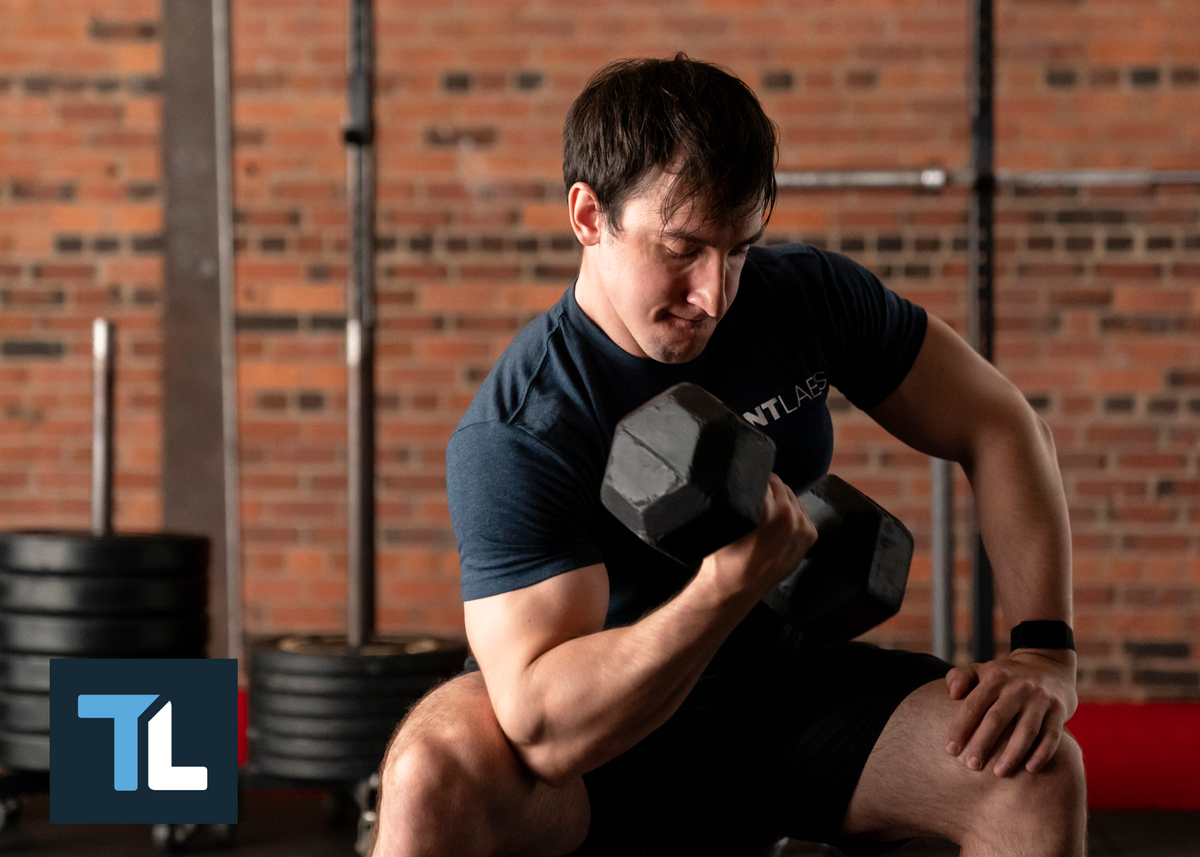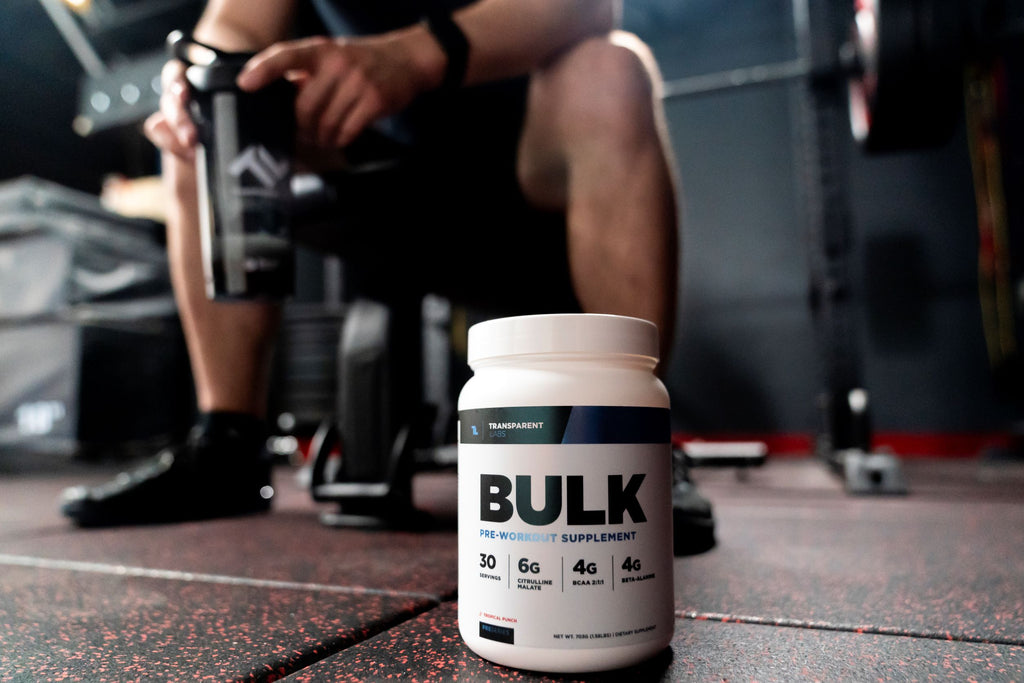The Ultimate Dumbbell Arm Workout for Big Biceps and Triceps

Try this Dumbbell Arm Workout to Grow Bigger Biceps and Triceps Fast
Have your arms not grown in seemingly forever? Far too often, gym-goers fall back on the same uninspired dumbbell arm workouts — treating their biceps and triceps like an afterthought on chest and back days.
And guess what? Their upper arm development reflects that. It's bizarre to think arm workouts aren't approached with the same intensity as any other muscle group.
However, the biceps and triceps are relatively small muscle groups and don't require tons of training volume to grow. The key is hitting them hard and frequently rather than pounding them into oblivion once a week.
As such, we suggest doing the dumbbell arm workout routine outlined herein once a week — on its own day — and then training your biceps and triceps again after your back and chest workouts, respectively.
As you progress through your arm workouts, focus on quality reps with good form. When in doubt, use dumbbells that are a little "too" light instead of trying to impress everyone — or your ego — with overly heavy weights.
Dumbbell Tricep and Bicep Exercises to Build Your Upper Arms
Below is a brief description of the bicep and tricep exercises included in the arm workout toward the bottom of this article. Most of these arm exercises have a shallow learning curve, making them ideal for lifters of any experience level.
Remember, proper form is essential for maximizing muscle growth. Control the weight and focus on the mind-muscle connection to maximize the pump in your upper arms:
Dumbbell Exercises for Biceps
-
Dumbbell Bicep Curls: Using a pronated (overhand) grip, hold a dumbbell in each hand with arms extended. Your palms should be facing toward the midline of your body, just outside of the thighs.
Now, alternating between your right arm and left arm, curl the dumbbell towards your chest by flexing the elbow joint and rotating your forearm until your palm is facing forward. Squeeze at the top, and then slowly lower the dumbbell to the starting position . (Do not swing the weight up; your upper body should remain relatively neutral throughout this exercise.)
Note: You don't have to rotate your forearm/wrist when doing dumbbell curls; it's actually quite a bit harder if you keep your palms supinated throughout the exercise.
-
Dumbbell Hammer Curls: This is the same movement as traditional dumbbell bicep curls, but your palms remain facing the midline of your body throughout. Again, keep your elbows tucked at your sides and don't cheat by swinging the weight up. Squeeze and hold at the top of the movement before returning to the starting position. You can alternate between each arm or do them in unison.
Additional Arm Exercises for Biceps
-
Cable Curls: Grab a straight bar cable attachment with an underhand grip. Place your hands just outside of your thighs and keep your elbows tucked at the sides. Curl the cable slowly up to your chest without swinging your body, squeeze at the top, and then slowly lower to the starting position.
-
Reverse-Grip EZ Bar Curls: Hold an EZ bar, or standard Olympic barbell, with an overhand grip at about shoulder width. Keeping your upper arms against your sides, curl the bar towards your chest until your arms are fully contracted. Slowly lower the weight back to starting position.
Dumbbell Exercises for Triceps
-
Overhead Triceps Extension with Dumbbell: Holding one end of a dumbbell with both hands, extend your arms fully so the dumbbell is situated vertically above the top of your head. Now, bend your elbows backward until the dumbbell is just behind your head, and then explode up by extending your elbow until your arms are nearly straight again. Do this in a slow, controlled fashion so you don't bump the back of your head. (Keep your head facing forward throughout the movement.)
-
Decline Dumbbell Skullcrusher: Position yourself on a decline bench with a dumbbell in each hand, placed on your thighs. Lie back on the bench as you extend your arms straight up to the ceiling. Make sure to keep your elbows bent slightly, and slowly lower the dumbbell weights towards your shoulders before extending them back to the starting position.
-
Dumbbell Triceps Kickback: This movement is excellent for stimulating the lateral head of the triceps muscle. With a dumbbell in one hand and knees slightly bent, bend forward at the waist until your torso is nearly parallel to the floor (much like the starting position of the dumbbell row).
Now row, the dumbbell up to your hips like you would when performing dumbbell rows. Make sure your shoulder joint is relaxed and your palms facing the midline of the body. The upper arm bone (humerus) should be parallel with your torso.
To complete a repetition, extend the elbow joint until your arm is straight, then lower the weight back to the starting position (elbow bent roughly 90 degrees). Do a set with your left/right arm then alternate to the other arm.
Additional Arm Exercises for Triceps

-
Close-Grip Bench press: Grasp the bar with an overhand grip placing your hands 8-12 inches apart. Unrack the weight and keep your elbows tucked at your sides. Slowly lower the bar to your chest before pushing the bar forcefully back to the start position.
-
Dips: Position yourself in the seated position on an upright bench. Extend the dumbbells behind the top of your head, with the dumbells oriented vertically. Flex your elbows and lower your torso (while maintaining a slight forward lean) until your elbow joint is bent 90 degrees. Extend the elbows by flexing your triceps and pressing off the bar until your arms are nearly straight and your torso is back to the starting position.
-
Tricep Pressdown: Attach a V-bar or rope to a high pulley. Next, grab the bar/rope with an overhand grip, making sure your thumbs are slightly higher than your pinky fingers. Keep your elbows tucked at your sides and push/press the down until your arms are straight. Pause before slowly returning to the starting position.
The Ultimate Upper-Arm Workouts for Mass
We recommend performing the following dumbbell arm workout in a superset fashion to increase intensity and blood flow to the upper-arm muscles. Supersets are great for arm workouts training since the biceps are antagonists of the triceps (e.g. push vs. pull). Once you've completed three sets of the first superset exercise pairing (i.e. A1 + B1) move on to the second superset, and so forth.
Training Tip: New trainees tend to obsess over their biceps and neglect their triceps, but the triceps are a larger and more powerful muscle group than the biceps. By training your triceps frequently, you can make your upper arms look bigger in a hurry.
Triceps Exercise Sets Rep Goal Overhead Dumbbell Triceps Extension (A1) 4 6-10 Dumbbell Skull-crushers (A2) 3 8-12 Dumbbell Triceps Kickback (A3) 3 12-15 Dips (A4) 3 AMRAP
Biceps Exercise Sets Rep Goal Standing Dumbbell Curl (B1) 3 10-12 Standing Dumbbell Hammer Curl (B2) 3 8-10 Cable Curl (B3) 3 12-15 Reverse-Grip EZ Bar Curl (B4) 3 15-20
*AMRAP = As many reps as possible
Arm Workouts FAQ
Q: How many warm-up sets should I do before training arms?
A: Warm-ups are just that, warm-ups; they should not be too taxing. Start off with 2-3 warm-up sets of 10-15 repetitions for the first biceps and triceps exercises you perform. After that, you can jump right into your working sets. (Once you have warmed up sufficiently, there is no need to do warm-ups for each subsequent exercise.)
Q: What's the best rep range for arm growth?
A: You will be working in the hypertrophy-focus range of 8 to 12 reps per set in the arm routine provided above. However, there is no "optimal" rep range for building your arms since training volume and training frequency determine the hypertrophic response to resistance training [1]. The key is consistency in your arm workouts and striving for progressive overload.
For example, when you can complete 3 sets of 12 reps on an exercise — with good form — increase the weight by a few pounds the following week. No matter what body part you are training, you should strive for progressive overload. Going through the motions with the same weight, sets, and reps every week is sure to lead to stagnation.
Q: How long are the rest periods between exercises and sets?
A: Rest a minimum of 60 seconds between supersets. If you need a little extra time to recover, take it. But keep in mind that the pump will be more intense if you maintain a quick, intense pace throughout the workout.
Don't make it a habit to talk with friends or mess around on your phone between sets. Focus on your workout and stay in the zone until you're done. You can chat it up and text afterward.
Tips for Maximizing Dumbbell Arm Workouts

- If you feel pain in your wrists, elbows, or shoulders while training your arms, don't force the issue. Elbow sleeves and wrists wraps may help.
- Keep your core engaged when doing arm exercises.
- Try changing the rep tempo to lengthen the time under tension when training triceps and biceps.
- If you plan on working out at home, adjustable dumbbells will come in handy.
- Take a clinically-dosed pre-workout supplement 30 minutes before training to maximize pumps, endurance, and blood flow.
Implement the superset arm workout above into your training routine once per week and watch your biceps and triceps grow! Of course, you should also train the rest of your upper body to keep everything in proportion — check out our Powerbuilding Guide for a detailed full-body workout routine.









